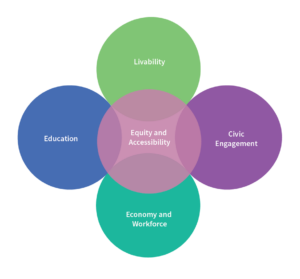Tacoma Strategic Plan
A strategic plan establishes priorities, provides long-term direction, and guides decision-making. Tacoma’s ten-year strategic plans are founded on the community’s priorities and vision and serve to identify the areas of emphasis for the City over this period of time. The 10-year plan provides a vision for the City.
Tacoma 2025 (2015 – 2025) has helped capture and operationalize the community’s vision. Tacoma 2035 (2025 – 2035) will be the City’s next 10-year strategic plan.
The City of Tacoma develops and updates three strategic plan documents every ten years at five year intervals (e.g., 2005, 2015, 2025, etc.):
- The 10-Year Strategic Plan (the City long-term strategic plan)
- The Comprehensive Plan (guides growth and development over 25 years)
- The Transportation and Mobility Plan (formerly Transportation Master Plan)
Tacoma 2025 Strategic Plan
Tacoma 2025 was adopted in 2015 as the long-term strategic plan for the City and represented the community’s vision for Tacoma’s future. With defined indicators and other ways to measure progress, it is a plan that guides where the City of Tacoma – as both a local government organization and a community – has been heading for the last 10 years.
The City works hard every day to ensure that the vision of Tacoma 2025 is being implemented in a way that improves the quality of life for everyone who lives, learns, works, and plays in Tacoma.
On January 27, 2015, the City Council approved Resolution 39016: A Resolution approving the City of Tacoma’s Ten-Year Citywide Strategic Plan and Vision, Tacoma 2025; and establishing the Tacoma 2025 Advisory Committee, to consist of 11 members to be appointed by the Mayor.
Tacoma 2035 Strategic Plan
Tacoma 2035 is currently under development with the goal of finalizing the strategic plan for the next ten years prior to the end of 2025.
Five Key Focus Areas
-

Tacoma residents have opportunities and amenities such as connected neighborhoods, accessible and efficient transportation options, and vibrant arts and culture while maintaining affordability.
Livability Indicators
- Improve access and proximity by residents to diverse income levels and race/ethnicity to community facilities, services, infrastructure, and employment.
- Increase the number of Complete Compact Communities/ 20-Minute Neighborhoods throughout the city.
- Improve health outcomes and reduce disparities, in alignment with the community health needs assessment and CHIP, for all Tacoma residents.
- Decrease the percentage of individuals who are spending more than 45% of income on housing and transportation costs.
- Increase positive public perception of safety and overall quality of life.
-

Tacoma Residents can find livable wage jobs in key industry areas. Tacoma will be a place of choice for employers, professionals and new graduates.
Economy/Workforce Indicators
- Increase the number of diverse livable wage jobs.
- Increase the number of Tacoma households that have livable wage jobs within proximity to the city.
- Increase the number of infrastructure projects and improvements that support existing and new business developments.
- Increase the availability of industry-specific education programs to support identified growth sectors.
- Increase the percentage of people relocating to the city and affordability of housing compared to neighboring jurisdictions.
- Decrease the number of vacant properties downtown and in the neighborhood business districts.
- Increase positive public perception related to the Tacoma economy.
-

Tacoma leads the region in education for youth and adults by producing more graduates from high school and college, linking residents to employment in the region, and investing in lifelong learning opportunities.
Education Indicators
- Increase the availability and accessibility of early childhood education programs.
- All students will graduate from high school and be prepared to enter the workforce or pursue post-secondary education.
- Increase the number of quality out of school time learning opportunities distributed equitably across the city.
- Demonstrate community support for education by increasing support for school levies and bonds; volunteering and mentoring youth.
- Increase the number of college students that find employment and remain in Tacoma after post-secondary completion.
- Increase digital access and equity across the city.
- Increase the number of adults with post-secondary degrees or certifications.
- Increase school choice options.
-

Tacoma residents are engaged participants in making Tacoma a well-run city. Elected and volunteer leadership of the city reflects the diversity of the city and residents fully participate in community decision making.
Civic Engagement Indicators
- Increase the number of residents who participate civically through volunteering and voting.
- Elected officials, boards, commissions, and volunteer leadership will reflect the diversity of the Tacoma community.
- Increase the percentage of residents who believe they are able to have a positive impact on the community and express trust in the public institutions in Tacoma.
- Representation at public meetings will reflect the diversity of the Tacoma community.
-

All residents are treated equitably and have access to services, facilities and financial stability.
Equity and Accessibility Indicators
- Improve access and proximity by residents to diverse income levels and race/ethnicity to community facilities, services, infrastructure, and employment.
- All students will graduate from high school and be prepared to enter the workforce or pursue post-secondary education.
- Increase the number of quality out of school time learning opportunities distributed equitably across the city.
- Decrease the percentage of individuals who are spending more than 45% of income on housing and transportation costs.
- Elected officials, boards, commissions, and volunteer leadership will reflect the diversity of the Tacoma community.
- Increase digital access and equity across the city.
- Representation at public meetings will reflect the diversity of the Tacoma community.
- Increase the number of Tacoma households that have livable wage jobs within proximity to the city.
Tacoma 2025 in Action

Setting the strategy for the entire city, Tacoma 2025 has been incorporated into every major planning process, including the OneTacoma Comprehensive plan, the Environmental Services Strategic Plan, the Affordable Housing Action Strategy, and the City budget process.
The One Tacoma plan guides decisions on land use, transportation, housing, capital facilities, parks and the environment, sets standards for roads and other infrastructure, identifies how they will be paid for, and establishes the basis for zoning and development regulations.
Another example of a strategic plan that incorporates the key focus areas outlined in Tacoma 2025 is the Environmental Services Strategic Plan, which will guide the City’s Environmental Services Department in its decision-making as they work to support healthy neighborhoods and a thriving Puget Sound in Tacoma.
The City’s Affordable Housing Action Strategy, which was developed as an urgent response to a changing housing market that is increasing displacement pressure for residents and a widespread need for high-quality, affordable housing opportunities for all, also incorporates the key focus areas outlined in Tacoma 2025.
Since the City’s 2019-2020 Biennial Budget planning process, every City department has incorporated goals relating to the key focus areas outlined in Tacoma 2025.